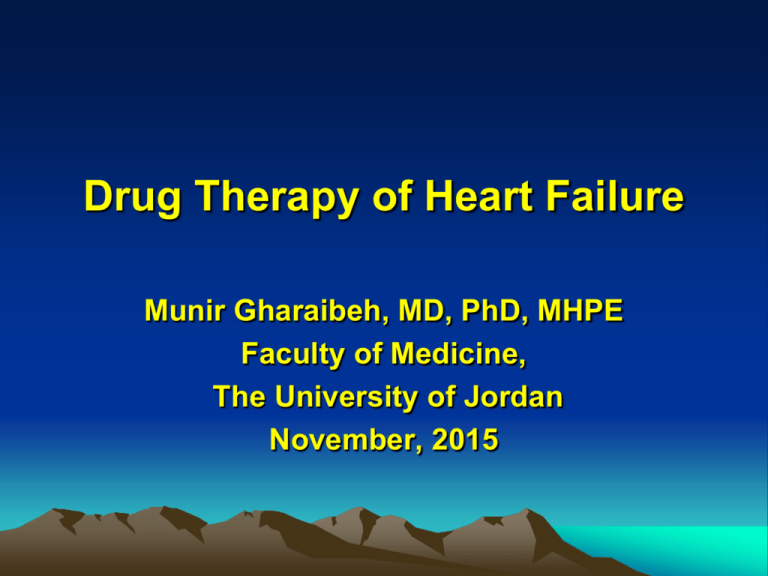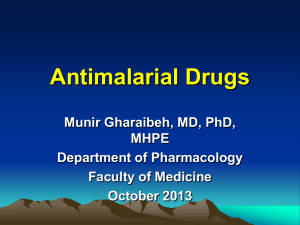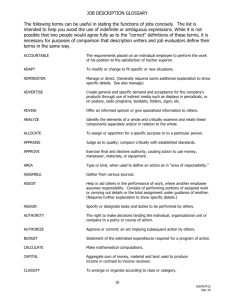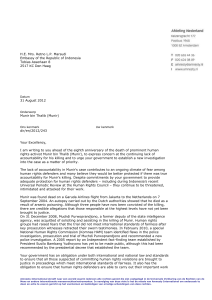ppt - Medicine Batch 2013-19 | University of Jordan
advertisement

Drug Therapy of Heart Failure Munir Gharaibeh, MD, PhD, MHPE Faculty of Medicine, The University of Jordan November, 2015 Drug Therapy of Heart Failure Definition of Heart Failure Causes Classifications Mar-16 Munir Gharaibeh, MD, PhD, MHPE 3 Definition of Heart Failure • Heart is unable to provide adequate perfusion of peripheral organs to meet their metabolic requirements • Characterized by: 1. Decreased CO 2. Increased TPR • Progression to congestive heart failure (CHF) is accompanied by peripheral and pulmonary edema. Mar-16 Munir Gharaibeh, MD, PhD, MHPE 4 Mar-16 Munir Gharaibeh, MD, PhD, MHPE 5 Mar-16 Munir Gharaibeh, MD, PhD, MHPE 6 Mar-16 Munir Gharaibeh, MD, PhD, MHPE 7 Mar-16 Munir Gharaibeh, MD, PhD, MHPE 8 Mar-16 Munir Gharaibeh, MD, PhD, MHPE 9 Compensatory Mechanisms in Heart Failure • Frank Starling Mechanism • • • • Increased Activity of SNS: a- Tachycardia and increased CO. b- Increased myocardial contractility c- Vasoconstriction leading to redistribution of blood to important viscera. d- Renin release leading to increased plasma volume. • • Myocardial Hypertrophy leading to increased wall tension. Mar-16 Munir Gharaibeh, MD, PhD, MHPE 10 Mar-16 Munir Gharaibeh, MD, PhD, MHPE 11 Compensatory SNS Mechanisms in HF • In a failing heart, the loss of contractile function leads to a decline in CO and a decrease in BP. • Baroreceptors sense the hemodynamic changes and initiate countermeasures to maintain support of the circulatory system. This is achieved by activation of the SNS. • This helps maintain adequate cardiac output by: 1. Increasing myocardial contractility and heart rate (β1-adrenergic receptors) 2. Increasing vasomotor tone (α1-adrenergic receptors) to maintain systemic blood pressure Mar-16 Munir Gharaibeh, MD, PhD, MHPE 12 Consequences of hyperadrenergic state • Enhancement of RAAS. • Over the long term, hyperadrenergic state leads to irreversible myocyte damage, cell death, and fibrosis. • In addition, the augmentation in peripheral vasomotor tone increases LV afterload. • This places an added stress upon the left ventricle and an increase in myocardial O2 demand (ventricular remodeling). • The frequency and severity of cardiac arrhythmias are enhanced in the failing heart Mar-16 Munir Gharaibeh, MD, PhD, MHPE 13 Angiotensin II facilitates NE release. Mar-16 Munir Gharaibeh, MD, PhD, MHPE 14 Mar-16 Munir Gharaibeh, MD, PhD, MHPE 15 Mar-16 Munir Gharaibeh, MD, PhD, MHPE 16 Signs and Symptoms of HF • • • • Tachycardia, sweating Decreased exercise tolerance & SOB Peripheral and pulmonary edema Cardiomegaly Mar-16 Munir Gharaibeh, MD, PhD, MHPE 17 Mar-16 Munir Gharaibeh, MD, PhD, MHPE 18 Factors that May Precipitate Acute Decompensation in Patients with Chronic Heart Failure Dietary indiscretion Myocardial ischemia/infarction Arrhythmias (tachycardia or bradycardia) Discontinuation of HF therapy Infection Anemia Initiation of medications that worsen HF: Calcium antagonists (verapamil, diltiazem) Beta blockers Nonsteroidal anti-inflammatory drugs Antiarrhythmic agents [all class I agents, sotalol (class III)] Anti-TNF antibodies Alcohol consumption Pregnancy Worsening hypertension AcuteMar-16 valvular insufficiency Munir Gharaibeh, MD, PhD, MHPE 19 • • • • • Objectives of Long Term Management of Chronic Cardiac Failure Improve cardiac performance (hemodynamics) at rest and during exercise. Relieve symptoms. Improve myocardial efficiency. Improve quality of life(particularly symptomfree and effort tolerance). Improve patient survival. Mar-16 Munir Gharaibeh, MD, PhD, MHPE 20 Cardiac vs Noncardiac Therapeutic Targets • Conventional belief that the primary defect in HF is in the heart. • Reality is that HF involves many other processes and organs. • Research has shown that therapy directed at noncardiac targets is more valuable than cardiac targets. • CHF should be viewed as a complex, interrelated sequence of events involving hemodynamic, and neurohormonal events. Mar-16 Munir Gharaibeh, MD, PhD, MHPE 21 Therapeutic Overview The Problems • Reduced force of contraction • Decreased cardiac output • Increased total peripheral resistance • Inadequate organ perfusion • Edema • Decreased exercise tolerance • Ischemic heart disease • Sudden death • Ventricular remodeling and decreased function Mar-16 Munir Gharaibeh, MD, PhD, MHPE 22 Mar-16 Munir Gharaibeh, MD, PhD, MHPE 23 Mar-16 Munir Gharaibeh, MD, PhD, MHPE 24 Drug Groups Commonly Used in Heart Failure. Diuretics Aldosterone receptor antagonists Angiotensin-converting enzyme inhibitors Angiotensin receptor blockers Beta blockers Cardiac glycosides Vasodilators Beta agonists Bipyridines Natriuretic peptide Mar-16 Munir Gharaibeh, MD, PhD, MHPE 25 Mar-16 Munir Gharaibeh, MD, PhD, MHPE 26 Causes of Diuretic Resistance in Heart Failure *Noncompliance with medical regimen; excess dietary Na+ intake *Decreased renal perfusion and glomerular filtration rate *Selective reduction in glomerular perfusion pressure following initiation (or dose increase) of ACE inhibitor therapy *Nonsteroidal antiinflammatory drugs *Primary renal pathology *Reduced or impaired diuretic absorption due to gut wall edema and reduced splanchnic blood flow Mar-16 Munir Gharaibeh, MD, PhD, MHPE 27 • The Relationship between the Renin-AngiotensinAldosterone System and Heart Failure Mar-16 Munir Gharaibeh, MD, PhD, MHPE 28 Effects of AT-II Mar-16 Munir Gharaibeh, MD, PhD, MHPE 29 Potential Roles of Aldosterone in the Pathophysiology of Heart Failure MECHANISM PATHOPHYSIOLOGICAL EFFECT Increased Na+ and water retention Edema, elevated cardiac filling pressures K+ and Mg2+ loss Arrhythmogenesis and risk of sudden cardiac death Reduced myocardial norepinephrine uptake Potentiation of norepinephrine effects: myocardial remodeling and arrhythmogenesis Reduced baroreceptor sensitivity Reduced parasympathetic activity and risk of sudden cardiac death Myocardial fibrosis, fibroblast proliferation Remodeling and ventricular dysfunction Alterations in Na+ channel expression Increased excitability and contractility of cardiac myocytes Mar-16 Munir Gharaibeh, MD, PhD, MHPE 31 Angiotensin Converting Enzyme Inhibitors "ACEI" • Pharmacological Actions: • • • • Blockade of ACE Reduce angiotensin II levels. Increase bradykinin. Inhibit SNS, leading to decreased NE release and upregulation of 1 receptors. • Balanced vasodilators causing reduction of both afterload and preload • Reduce myocyte & fibroblast growth factors causing reduced cardiac remodeling. • Decrease aldosterone causing decreased fluid retention, decreased K+ loss, and consequently reduced arrhythmias. Mar-16 Munir Gharaibeh, MD, PhD, MHPE 32 Mar-16 Munir Gharaibeh, MD, PhD, MHPE 33 Therapeutic Values of ACEI • • • • • Nowadays drugs of choice. No tolerance. Retard progression of HF. Decrease arrhythmias. The only drugs which decrease mortality, but only when the highest tolerated doses are used. Mar-16 Munir Gharaibeh, MD, PhD, MHPE 34 Preparations of ACEI • • • • • Captopril Enalapril Lisinopril Quinapril Fosinopril All are similarly effective Might differ in toxicity Mar-16 Munir Gharaibeh, MD, PhD, MHPE 35 Toxicity of ACEI • • • • Hypotension ……… First dose phenomenon Renal Impairment ............ Proteinurea K+ retention Cough Mar-16 Munir Gharaibeh, MD, PhD, MHPE 36 Angiotensin (AT1) Receptor Blockers ARBs • • • • • Losartan. Candesartan. Valsartan. Irbesartan(Approvel). Telmisartan(Micardis). Not superior to ACEIs, but may be useful for patients who can not tolerate ACEIs because of cough. Mar-16 Munir Gharaibeh, MD, PhD, MHPE 37 Beta Blockers • Traditionally, they have negative inotropic effects. • However, nowadays there is overwhelming evidence to support the use of β-blockers in CHF. • Not useful in refractory HF. • Mechanism involved remains unclear. • Part of their beneficial effects may derive from slowing of heart rate, decreased cardiac work and consequently decreased myocardial O2 consumption and enhanced efficiency. • This would lessen the frequency of ischemic events and arrhythmias. Mar-16 Munir Gharaibeh, MD, PhD, MHPE 38 Beta blockers • Suggested mechanisms also include reduced remodeling of the heart muscle. • β-Blockers may be beneficial through resensitization of the down-regulated receptor, thus improving myocardial contractility. • Should be started with low doses and gradually increased. • Recent studies with metoprolol, carvedilol, bicindolol, and bisiprolol showed a reduction in mortality in patients with these drugs. • This does not mean that other older agents are not effective. • Contraindicated in sever, refractory, unstable cases. Mar-16 Munir Gharaibeh, MD, PhD, MHPE 39 Mar-16 Munir Gharaibeh, MD, PhD, MHPE 40 Mar-16 Munir Gharaibeh, MD, PhD, MHPE 41 Positive Inotropic Agents • Logically will improve cardiac function. • These drugs increase force of contraction by increasing intracellular cardiac Ca++ concentration. • Cyclic AMP Independent Agents: Digitalis Pimobendan • Cyclic AMP Dependant Agents: -adrenergic Agonists Phosphodiesterase Inhibitors Mar-16 Munir Gharaibeh, MD, PhD, MHPE 42 Role of Calcium and Sodium in Myocardial contraction Mar-16 Munir Gharaibeh, MD, PhD, MHPE 43 Mar-16 Munir Gharaibeh, MD, PhD, MHPE 44 Positive Inotropic Agents Cyclic AMP Independent Agents: • Digitalis: inhibits Na/KATPase. • Pimobendan: sensitizes myocytes to Ca++, also inhibits PDE. Mar-16 Munir Gharaibeh, MD, PhD, MHPE 45 Digitalis Glycosides History: • Egyptians ------Squill((العنصل • Chinese -------Toad skin • William Withering ----- Foxglove 1785 • Digitalis purpura • Digitalis lanata • Strophanthus Mar-16 Munir Gharaibeh, MD, PhD, MHPE 46 Mar-16 Munir Gharaibeh, MD, PhD, MHPE 47 Digitalis Glycosides Mechanism: • Mar-16 Inhibition of Na+/K+ ATPase Munir Gharaibeh, MD, PhD, MHPE 48 Mar-16 Munir Gharaibeh, MD, PhD, MHPE 49 Mar-16 Munir Gharaibeh, MD, PhD, MHPE 50 Digitalis Glycosides Actions: • • • • Positive Inotropic Effect Vascular Muscle Contraction Vagal Stimulation Effects on Electrical Properties of Cardiac Tissues. Mar-16 Munir Gharaibeh, MD, PhD, MHPE 51 (Heart and Vascular Muscle) Mar-16 Munir Gharaibeh, MD, PhD, MHPE 52 Effects of Digoxin on Electrical Properties of Cardiac Tissues. Tissue or Variable Effects at Therapeutic Doses(vagal Stimulation) Sinus node Rate Atrial muscle Refractory period Effects at Toxic Doses Rate Refractory period, arrhythmias Atrioventricular node Conduction velocity, refractory period Refractory period, arrhythmias Purkinje system, ventricular muscle Slight Extrasystoles, tachycardia, fibrillation Electrocardiogram Mar-16 refractory period PR interval, QT interval Munir Gharaibeh, MD, PhD, MHPE Tachycardia, fibrillation, arrest at extremely high 53 dosage Digitalis Toxicity • G.I.T.(Anorexia, nausea, intestinal cramping, diarrhea) • Visual (Xanthopsia, abnormalities in color vision) • Neurologic(Malaise, confusion, depression, vertigo) • Cardiac (bradycardia, Palpitations, syncope, arrhythmias, AV node block, ventricular tachycardia). • Interactions. • Pharmacological and toxic effects are greater in hypokalemic patients. • K+-depleting diuretics are a major contributing factor to digoxin toxicity. Mar-16 Munir Gharaibeh, MD, PhD, MHPE 54 Mar-16 Munir Gharaibeh, MD, PhD, MHPE 55 Digitalis Toxicity Treatment of Toxicity: Reduce or stop the drug. Cardiac pacemeker for heart block. Digitalis antibodies( Digoxin Immune Fab). Arrhythmias may be converted to normal sinus rhythm by K+ when the plasma K+ conc. is low or within the normal range. When the plasma K+ conc is high, antiarrhythmic drugs, such as lidocaine, phenytoin, procainamide, or propranolol, can be used. Mar-16 Munir Gharaibeh, MD, PhD, MHPE 56 Digitalis Glycosides Therapeutic Benefits: • Nowadays, only useful in CCHF with supraventricular – – – Mar-16 arrhythmia Might decrease morbidity ? Withdrawal ? Mortality Munir Gharaibeh, MD, PhD, MHPE 57 Mar-16 Munir Gharaibeh, MD, PhD, MHPE 58 Positive Inotropic Agents Cyclic AMP Dependent Agents: -adrenergic Agonists: NE Dopamine Dobutamine Phosphodiesterase Inhibitors: Mar-16 Amrinone Inamrinone Milrinone Vesanirone SildenafilMunir Gharaibeh, MD, PhD, MHPE 59 Positive Inotropic Agents Cyclic AMP Dependent Agents: -adrenergic Agonists: All increase myocardial oxygen consumption, so not helpful for chronic use, may be used (IV) for short term or in acute heart failure. NE: Was used in cardiogenic shock, but caused severe vasospasm and gangrene . Ep: Still used in cardiac arrest, by intracardiac injection. Mar-16 Munir Gharaibeh, MD, PhD, MHPE 60 Positive Inotropic Agents Dopamine: Widely used in cardiogenic shock. Low doses: stimulate DA1 receptors leading to renal vasodilation and improved renal function. Intermediate doses: work on β1 receptors leading to positive inotropic actions. High doses: stimulate α receptors leading to vasoconstriction and elevation of blood pressure. Can cause arrhythmias and ischemic changes. Dobutamine: Selective β1 agonist, used intermittently (IV) in CCHF. Produces mild vasodilation. Has more inotropic than chronotropic actions. Mar-16 Munir Gharaibeh, MD, PhD, MHPE 61 Mar-16 Munir Gharaibeh, MD, PhD, MHPE 62 Positive Inotropic Agents Phosphodiesterase Inhibitors: PDE inhibition leads to accumulation of cAMP and cGMP leading to positive inotropic activity and peripheral vasodilation. Toxic: arrhythmias, and thrombocytopenia. Short acting, so reserved for parenteral therapy of acute heart failure. Mar-16 Inamrinone (PDE-3) Milrinone (PDE-3) Vesanirone (PDE-3) SildenafilMunir(PDE-5) Gharaibeh, MD, PhD, MHPE 63 Vasodilators • Affect preload and/or afterload without directly affecting contractility. • Consequently can decrease myocardial ischemia, enhance coronary blood flow and decrease MVO2. • Can be used in acute heart failure and for short periods in CCHF. • Hydralazine-Isosorbide dinitrate combination was found to decrease mortality, maybe by reducing remodeling of the heart. • Can be combined with ACEI, diuretics and digitalis. Mar-16 Munir Gharaibeh, MD, PhD, MHPE 64 Mar-16 Munir Gharaibeh, MD, PhD, MHPE 65 Mar-16 Munir Gharaibeh, MD, PhD, MHPE 66 Vasodilator Drugs Used to Treat Heart Failure DRUG CLASS EXAMPLES MECHANISM OF VASODILATING ACTION PRELOAD REDUCTION AFTERLOAD REDUCTION Organic nitrates Nitroglycerin, isosorbide dinitrate NO-mediated vasodilation +++ + Nitric oxide donors Nitroprusside NO-mediated vasodilation +++ +++ Angiotensinconverting enzyme inhibitors Captopril, enalapril, lisinopril Inhibition of Ang II generation, decreased bradykinin degradation ++ ++ Angiotensin receptor blockers Losartan, candesartan Blockade of AT1 receptors ++ ++ Phosphodiesterase inhibitors Milrinone, inamrinone Inhibition of cyclic AMP degradation ++ ++ Direct-acting K+channel agonist Hydralazine Unknown + +++ Minoxidil Hyperpolarization of vascular smooth muscle cells + +++ a 1 Adrenergic Doxazosin, prazosin Selective 1 adrenergic receptor blockade +++ ++ Nonselective adren ergic antagonists Phentolamine Nonselective adrenergic receptor blockade +++ +++ Vasodilating adrenergic antagonists Carvedilol, labetalol Selective 1 adrenergic receptor blockade ++ ++ Amlodipine, nifedipine, felodipine Inhibition of L-type Ca2+ channels + +++ + ++ antagonists / 1 Ca2+ channel blockers Mar-16 adrenergic Isoproterenol Munir Gharaibeh, MD, PhD, MHPE Stimulation of vascular 2 67 Mar-16 Munir Gharaibeh, MD, PhD, MHPE 68 (BNP)-Niseritide • Brain (B-type) natriuretic peptide (BNP) is secreted constitutively by ventricular myocytes in response to stretch. • BNP binds to receptors in the vasculature, kidney, and other organs, producing potent vasodilation with rapid onset and offset of action by increasing levels of cGMP. • Niseritide is a recombinant human BNP approved for treatment of acute decompensated CHF. Mar-16 Munir Gharaibeh, MD, PhD, MHPE 69 (BNP)-Niseritide • Reduces systemic and pulmonary vascular resistances, causing an indirect increase in cardiac output and diuresis. • Effective in HF because of reduction in preload and afterload. • Hypotension is the main side effect. Mar-16 Munir Gharaibeh, MD, PhD, MHPE 70 Mar-16 Munir Gharaibeh, MD, PhD, MHPE 71 Mar-16 Munir Gharaibeh, MD, PhD, MHPE 72 Steps in the Prevention and Treatment of Chronic Heart Failure. ACC/AHA Stage Step1 Intervention A, B 1 Control hypertension, hyperlipidemia, glucose metabolism (diabetes), obesity C 2 Reduce workload of the heart (limit activity, put on temporary bed rest) 3 Restrict sodium intake, give diuretics 4 Restrict water (rarely required) 5 Give angiotensin-converting enzyme inhibitor or angiotensin receptor blocker 6 Give digitalis if systolic dysfunction with third heart sound or atrial fibrillation is present 7 Give beta blockers to patients with stable class II–IV heart failure 8 Give aldosterone antagonist 9 Give vasodilators C, D D Mar-16 10 Munir Gharaibeh,resynchronization MD, PhD, MHPE Cardiac 73 is if wide QRS interval Errors in Management of HF • • • • Missed diagnosis. Improper dosage of diuretics. Failure to assess quality of life. Failure to consider long term therapeutic goals. • Underprescribing of ACEI. • Use of potentially harmful drugs. • Failure to use hydralazine-isosorbide combination which has proved evidence of benefit. Mar-16 Munir Gharaibeh, MD, PhD, MHPE 74 Mar-16 Munir Gharaibeh, MD, PhD, MHPE 75



